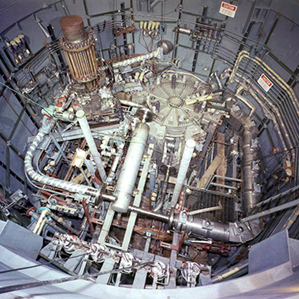Meltdown-Proof Nuclear Reactors Get a Safety Check in Europe
For years nuclear scientists have talked about a revival of molten-salt reactors, which are powered by a liquid fuel rather than solid fuel rods, as a way to help spark the long-awaited “nuclear renaissance.” Recent developments indicate that this alternative nuclear reactor design is finally making gradual progress toward commercialization.

In August a consortium of research institutes and universities working under the aegis of the European Commission, including the Technology University of Delft (TU Delft) in the Netherlands, France’s National Center for Scientific Research, and the Commission’s Joint Research Center in Brussels, embarked on a four-year research program designed to demonstrate the safety benefits of molten-salt reactors. Called “Safety Assessment of the Molten Salt Fast Reactor,” or Samofar, the effort will lead to a prototype reactor in the early 2020s if all goes as planned.
First built and tested in the 1960s, at Oak Ridge National Laboratory, molten-salt reactors would be the first genuinely new technology for nuclear power generation to reach the market in the last three decades. Producing zero carbon, they use a radioactive solution that blends nuclear fuel with a liquid salt. They can run on uranium but are also ideally suited for thorium, an alternative nuclear fuel that is cleaner, safer, and more abundant than uranium.
Molten-salt reactors also offer inherent safety advantages: because the fuel is liquid, it expands when heated, thus slowing the rate of nuclear reactions and making the reactor self-governing. And they’re built like bathtubs, with a drain in the bottom that’s blocked by a “freeze plug.” If anything goes wrong, the freeze plug melts and the reactor core drains into a shielded underground container. They can operate as producers of thermal power or as “burner” reactors that consume nuclear waste from conventional reactors.
Essentially, molten-salt reactors could solve the two problems that have bedeviled the nuclear power industry: safety and waste.
While the advantages of molten-salt reactors have been understood for some time, they remain at the R&D stage because, in the post-Fukushima era of low-price natural gas, it’s hard to convince investors to fund any alternative nuclear technology. In the United States it can take a decade or more, and hundreds of millions of dollars, just to bring a new reactor design to the Nuclear Regulatory Commission for a license application.
Samofar is focused on fast reactors, which are more efficient than conventional light-water reactors and can breed fissile elements from nuclear waste. The researchers will build experimental laboratory facilities—not, at least for the next few years, an actual working reactor—to test the geometry of the freeze plug, the coatings of vessel and pipe materials, the behavior of the liquid fuel during circulation and draining, and other key safety metrics.
The project represents “the first step toward large-scale validation and demonstration of the technology,” says Jan-Leen Kloosterman, a professor of nuclear physics at TU Delft and the lead researcher on Samofar. “Hopefully the results will also lead to much more commitment from the large nuclear industry.”
Getting that commitment remains an uphill struggle, but a report funded by the government of the United Kingdom and released recently by Energy Process Developments, a London-based research firm, reviews technologies from six potential developers of molten-salt reactor—Flibe Energy, Moltex Energy, ThorCon Power, Seaborg Technologies, Terrestrial Energy, and Transatomic Power—and finds encouraging signals for the next 10 years (see “Experiments Start on a Meltdown-Proof Nuclear Reactor”). After a decade of work, the companies “are ready now with proposals for the next step to implementation, namely engineering design to prepare the safety case and to proceed to design and build.”
The most advanced program for liquid-fuel, thorium-based reactors is in China, where the Shanghai Institute of Applied Physics reportedly plans to build a prototype in the next few years. The Shanghai program is a collaboration with Oak Ridge National Laboratory, where molten salt nuclear technology was born.
Keep Reading
Most Popular
Large language models can do jaw-dropping things. But nobody knows exactly why.
And that's a problem. Figuring it out is one of the biggest scientific puzzles of our time and a crucial step towards controlling more powerful future models.
How scientists traced a mysterious covid case back to six toilets
When wastewater surveillance turns into a hunt for a single infected individual, the ethics get tricky.
The problem with plug-in hybrids? Their drivers.
Plug-in hybrids are often sold as a transition to EVs, but new data from Europe shows we’re still underestimating the emissions they produce.
Google DeepMind’s new generative model makes Super Mario–like games from scratch
Genie learns how to control games by watching hours and hours of video. It could help train next-gen robots too.
Stay connected
Get the latest updates from
MIT Technology Review
Discover special offers, top stories, upcoming events, and more.